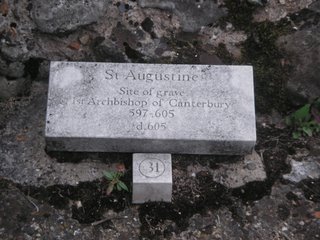The Tomb of St Augustine

While in Canterbury I visited St Augustine's Abbey, originally founded by St Augustine and given the Roman dedication of SS Peter and Paul. Indeed Canterbury became a Kentish version of Rome, complete with a Cathedral dedicated to the Saviour - like the Lateran - and churches named after St Pancras and the Four Crowned Martyrs.
The liturgy of the early Canterbury Church attempted to imitate that of Rome – hardly surprising since St Augustine’s monks had been formed in a Roman environment. Even in the eighth century, Canterbury was still seen as a centre of chant ‘in the Roman manner’ – in 709 Bishop Acca of Hexham appointed a certain Maban as chanter, who had been trained ‘by the successors of the disciples of Gregory in Kent.’ Although no liturgical books survive, the Order of Mass was probably Roman, with a Frankish flavour, since Gregory had encouraged Augustine to adopt those practices of the Frankish Church that met with his approval. Even the early Cathedral was, in the words of the early twelfth century historian, Eadmer, ‘in some parts in imitation of the church of the blessed prince of the apostles, Peter.’ Historian Nicholas Brooks has shown that the pre-Conquest Cathedral was bi-polar in structure, so that ‘the Canterbury priest who celebrated mass at the altar of St Mary stood behind the altar and faced eastwards towards the people below, like the celebrant in the Roman basilicas.’

The Abbey became a mausoleum for the Kings of Kent and the early Archbishops of Canterbury. St Augustine's body was interred in the north porticus of the Abbey, where his immediate successors, Archbishops Mellitus, Justus, Honorius and Deusdedit, later joined him. These were unusual tombs (possibly based on contemporary Italian models), consisting of a wooden coffin placed in a pit and preserved in concrete, with the lid protruding. According to Alan Thacker, these ‘early archiepiscopal burials were envisaged as honoured graves appropriate to high ecclesiastics rather than as shrines.’ Indeed, they were arranged in a cramped space with little space for liturgical ceremonies or private pilgrim devotions.
Bede records his epitaph:
Here lies the most reverend Augustine, first archbishop of Canterbury, who was formerly sent hither by St Gregory, bishop of Rome; being supported by God in the working of miracles, he led King Ethelbert and his nation from the worship of idols to faith in Christ and ended his days of his office in peace: he died on the twenty-sixth day of May during the reign of the same king.At first St Augustine remained in the shadow of Pope Gregory and comes across as a rather colourless figure in Bede. Despite his contacts with Abbot Albinus of Canterbury, Bede may have lacked information about Augustine, but he also may have been promoting a deliberately Northumbria-centric history. Bede recognised the importance of the conversion of the Kingdom of Kent but firmly places his native Northumbria in the limelight. It is Aidan rather than Augustine, Edwin and Oswald rather than Ethelbert – in a sense York rather than Canterbury - that stands out in his History. Whenever we read early histories of the conversion of England, we need to bear in mind the rivalry with the ecclesiastical establishment at Canterbury and disputes over the Archbishop’s primacy.
They may even have a deliberate strategy in the early eighth century based not in Northumbria but at Canterbury itself that aimed to downplay the role of St Augustine and emphasise St Gregory as the apostolic evangelist of England. This fitted in with the pretensions of St Theodore who styled himself as ‘archbishop of the island of Britain.’
The cult of St Augustine only seems to have taken off from the mid eighth century. In 978 his Abbey was rededicated to ‘SS Peter and Paul and St Augustine.’ Curiously, it seems that the Normans rather the Saxons did the most to promote his cult. In 1091 the early Archbishops’ remains were solemnly translated to a new shrine inside the church – an effort on Abbot Wido’s part to unite a divided house and restate the Abbey’s ancient traditions and spiritual treasures. The event occasioned various works on Augustine and the other early Archbishops by Goscelin of Saint-Bertin, including two lives and a book of Miracles.
St Augustine’s bones were moved once again in 1221, by which time a separate reliquary contained his head. Pilgrims visited his tomb but this was always second best, compared to the glittering collection of shrines to be found in the city and, from the end of the twelfth century, the tomb of Becket. Even in the Abbey church itself, the main attraction from 1030 onwards was the shrine of St Mildred of Minster, which stood before the High Altar. Moreover, even in the writings of Goscelin, the cult is often presented in terms of the early Archbishops of Canterbury together (SS Augustine, Mellitus, Justus, Honorius and Deusdedit) rather than simply St Augustine himself. Thus the crippled eleventh century pilgrim, Leodegar, was reported to being healed after witnessing a vision of the group of Archbishops at their tombs.
St Augustine’s shrine was, of course, destroyed at the Reformation. According to Archdeacon Nicholas Harpsfield, the saint’s bones were burnt, although there is a tradition that the body was saved by Edward Thwaites (of Easture and East Stour) and moved for safekeeping to St Mary’s church at Chilham. An ancient sarcophagus with a cross on its lid is sometimes identified as St Augustine’s, although the bones have been lost.



1 Comments:
Many thanks, Father. Of course, if you manage to get inside St Martin's church there are postacards on sale showing the resident minister "presiding" at communion in a matching ensemble of chalice veil, chasuble and altar frontal, which I know you would envy. It appears to show swirling galaxies or sonething. Just the right note for this old church. Thanks for the pictures!
Post a Comment
<< Home